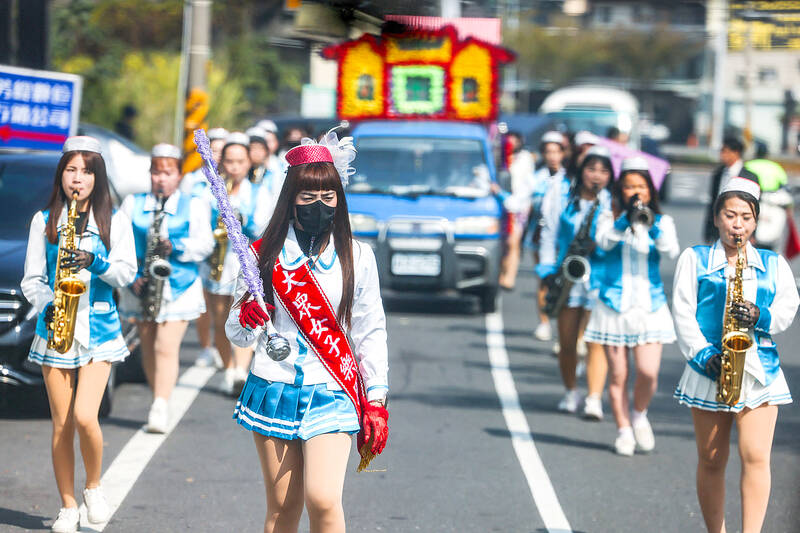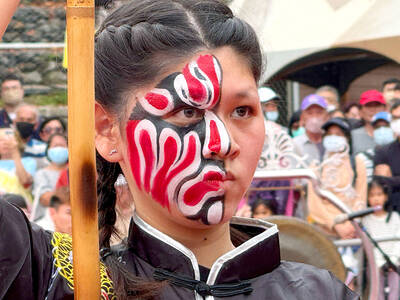At a funeral in rural Changhua County, musicians wearing pleated mini-skirts and go-go boots march around a coffin to the beat of the 1980s hit I Hate Myself for Loving You. The performance in a rural farming community is a modern mash-up of ancient Chinese funeral rites and folk traditions, with saxophones, rock music and daring outfits.
Da Zhong (大眾) women’s group is part of a long tradition of funeral marching bands performing in mostly rural areas of Taiwan for families wanting to give their loved ones an upbeat send-off. The band was composed mainly of men when it started 50 years ago and has evolved into an all-women ensemble.
“I constantly try to innovate, come up with new ideas, and adapt to modern times,” said band manager Hsu Ya-tzu, 46, whose mother-in-law founded the group. “I want to break away from rigid traditional mindsets to keep this profession relevant.”

Photo: AFP
Starting before dawn, the women marched in formation playing their saxophones and a drum as the leader twirled her baton and blew a whistle.
The music was loud enough to wake the nearby living as they led the coffin and mourners to a cemetery or crematorium where traditional funeral rites were performed.
“It felt like a celebration, almost like a joyous occasion rather than a funeral,” said mourner Hsiao Lin Hui-hsiang, 74, as his family cremated an elderly relative.
“Since she lived past 90, it was considered a happy farewell.”
Funeral director Chang Chen-tsai said marching band performances were supposed to “liven up the atmosphere” of funerals and were usually reserved for the old.
“It should be lively, it cannot be too quiet,” said Chang, 64, who has been organizing funerals for 40 years.
LIPSTICK, WHITE BOOTS
It was still dark out when Hsu pulled up in her van at a meeting point to collect other band members for an early morning gig. The women aged from 22 to 46 applied lipstick and pulled on white boots before grabbing their instruments and walking to the covered courtyard venue where mourners gathered near the coffin.
Hsu’s mother-in-law, Hung Sa-hua, recalls being one of the only women in the funeral marching band profession when she started her own group in 1975.
As the male performers got old and retired, she replaced them with women, which customers preferred, the 72-year-old said.
For Hung, the band was an opportunity to make some extra money after she married her husband and to get out of the family home.
“If I never went out and always stayed at home, I wouldn’t have known what was happening in society,” Hung said.
‘CONSTANTLY INNOVATING’
Taiwan’s funeral marching bands are rooted in Chinese and folk rituals, and during the last century began using Western instruments, said Wu Ho-yu, 56, a high school music teacher who has studied the tradition.
“Since people appreciate its entertainment aspect, bands continue following this style, constantly innovating to offer something even better,” Wu said.
Hsu said the band had changed with the times. Many years ago, for example, the women wore trousers but now super-short skirts were acceptable. Finding new performers was a challenge due to the early morning starts, said Hsu, who has expanded into birthday parties, company year-end events and grand openings.
“Nowadays, fewer and fewer people are willing to enter this industry,” she said. “We are all getting older, but this job needs young people to carry it forward, it requires energy, and only with energy can it truly shine.”
Hsu said she introduced rock songs — such as I Hate Myself for Loving You by US band Joan Jett and the Blackhearts and Leaving the Face of the Earth (Jump!) by Taiwanese group Mayday — into their repertoire to give their act a more contemporary sound.
Some elderly mourners initially objected, but younger ones embraced it.
“As long as it’s a song the deceased wanted to hear, anything is okay,” Hsu said.
“The old traditions, where certain songs were considered taboo, no longer apply.”

The People’s Republic of China (PRC) last week offered us a glimpse of the violence it plans against Taiwan, with two days of blockade drills conducted around the nation and live-fire exercises not far away in the East China Sea. The PRC said it had practiced hitting “simulated targets of key ports and energy facilities.” Taiwan confirmed on Thursday that PRC Coast Guard ships were directed by the its Eastern Theater Command, meaning that they are assumed to be military assets in a confrontation. Because of this, the number of assets available to the PRC navy is far, far bigger

The 1990s were a turbulent time for the Chinese Nationalist Party’s (KMT) patronage factions. For a look at how they formed, check out the March 2 “Deep Dives.” In the boom years of the 1980s and 1990s the factions amassed fortunes from corruption, access to the levers of local government and prime access to property. They also moved into industries like construction and the gravel business, devastating river ecosystems while the governments they controlled looked the other way. By this period, the factions had largely carved out geographical feifdoms in the local jurisdictions the national KMT restrained them to. For example,

The remains of this Japanese-era trail designed to protect the camphor industry make for a scenic day-hike, a fascinating overnight hike or a challenging multi-day adventure Maolin District (茂林) in Kaohsiung is well known for beautiful roadside scenery, waterfalls, the annual butterfly migration and indigenous culture. A lesser known but worthwhile destination here lies along the very top of the valley: the Liugui Security Path (六龜警備道). This relic of the Japanese era once isolated the Maolin valley from the outside world but now serves to draw tourists in. The path originally ran for about 50km, but not all of this trail is still easily walkable. The nicest section for a simple day hike is the heavily trafficked southern section above Maolin and Wanshan (萬山) villages. Remains of

Shunxian Temple (順賢宮) is luxurious. Massive, exquisitely ornamented, in pristine condition and yet varnished by the passing of time. General manager Huang Wen-jeng (黃文正) points to a ceiling in a little anteroom: a splendid painting of a tiger stares at us from above. Wherever you walk, his eyes seem riveted on you. “When you pray or when you tribute money, he is still there, looking at you,” he says. But the tiger isn’t threatening — indeed, it’s there to protect locals. Not that they may need it because Neimen District (內門) in Kaohsiung has a martial tradition dating back centuries. On